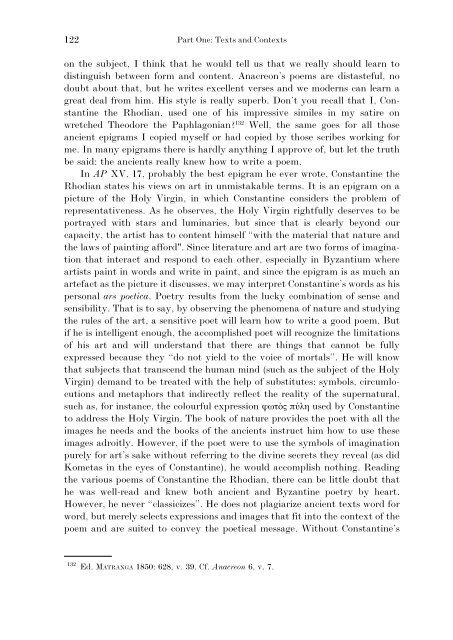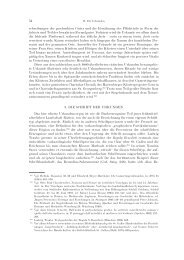Chapter Three ANTHOLOGIES AND ANTHOLOGISTS Between c ...
Chapter Three ANTHOLOGIES AND ANTHOLOGISTS Between c ...
Chapter Three ANTHOLOGIES AND ANTHOLOGISTS Between c ...
Create successful ePaper yourself
Turn your PDF publications into a flip-book with our unique Google optimized e-Paper software.
122<br />
Part One: Texts and Contexts<br />
on the subject, I think that he would tell us that we really should learn to<br />
distinguish between form and content. Anacreon’s poems are distasteful, no<br />
doubt about that, but he writes excellent verses and we moderns can learn a<br />
great deal from him. His style is really superb. Don’t you recall that I, Constantine<br />
the Rhodian, used one of his impressive similes in my satire on<br />
wretched Theodore the Paphlagonian? 132 Well, the same goes for all those<br />
ancient epigrams I copied myself or had copied by those scribes working for<br />
me. In many epigrams there is hardly anything I approve of, but let the truth<br />
be said: the ancients really knew how to write a poem.<br />
In AP XV, 17, probably the best epigram he ever wrote, Constantine the<br />
Rhodian states his views on art in unmistakable terms. It is an epigram on a<br />
picture of the Holy Virgin, in which Constantine considers the problem of<br />
representativeness. As he observes, the Holy Virgin rightfully deserves to be<br />
portrayed with stars and luminaries, but since that is clearly beyond our<br />
capacity, the artist has to content himself “with the material that nature and<br />
the laws of painting afford". Since literature and art are two forms of imagination<br />
that interact and respond to each other, especially in Byzantium where<br />
artists paint in words and write in paint, and since the epigram is as much an<br />
artefact as the picture it discusses, we may interpret Constantine’s words as his<br />
personal ars poetica. Poetry results from the lucky combination of sense and<br />
sensibility. That is to say, by observing the phenomena of nature and studying<br />
the rules of the art, a sensitive poet will learn how to write a good poem. But<br />
if he is intelligent enough, the accomplished poet will recognize the limitations<br />
of his art and will understand that there are things that cannot be fully<br />
expressed because they “do not yield to the voice of mortals”. He will know<br />
that subjects that transcend the human mind (such as the subject of the Holy<br />
Virgin) demand to be treated with the help of substitutes: symbols, circumlocutions<br />
and metaphors that indirectly reflect the reality of the supernatural,<br />
such as, for instance, the colourful expression uztñß p7lh used by Constantine<br />
to address the Holy Virgin. The book of nature provides the poet with all the<br />
images he needs and the books of the ancients instruct him how to use these<br />
images adroitly. However, if the poet were to use the symbols of imagination<br />
purely for art’s sake without referring to the divine secrets they reveal (as did<br />
Kometas in the eyes of Constantine), he would accomplish nothing. Reading<br />
the various poems of Constantine the Rhodian, there can be little doubt that<br />
he was well-read and knew both ancient and Byzantine poetry by heart.<br />
However, he never “classicizes”. He does not plagiarize ancient texts word for<br />
word, but merely selects expressions and images that fit into the context of the<br />
poem and are suited to convey the poetical message. Without Constantine’s<br />
132 Ed. MATRANGA 1850: 628, v. 39. Cf. Anacreon 6, v. 7.




